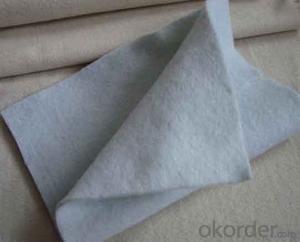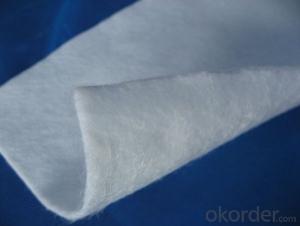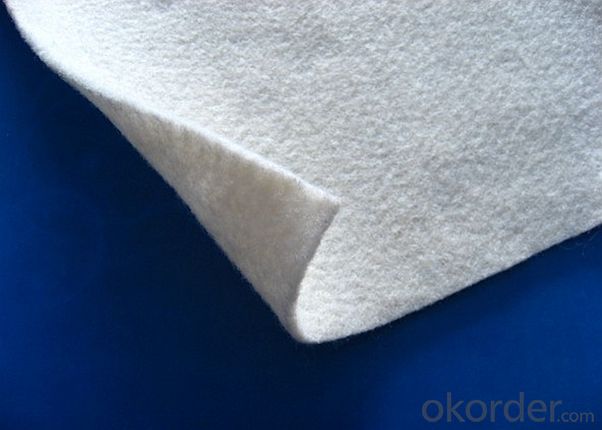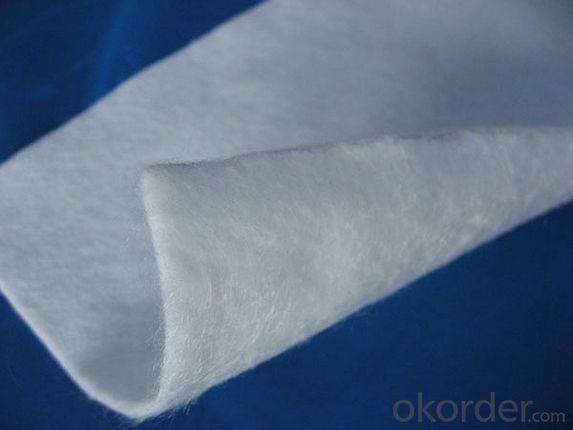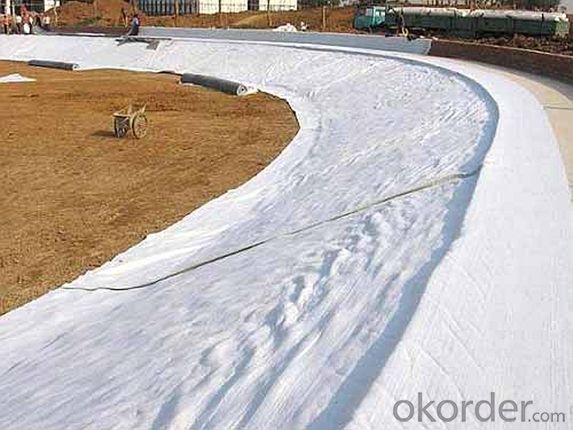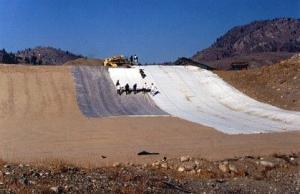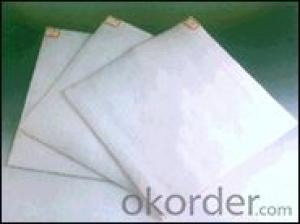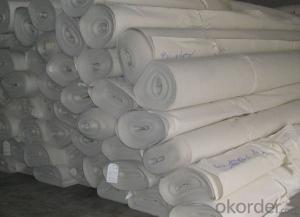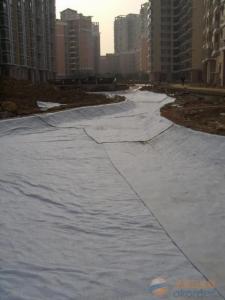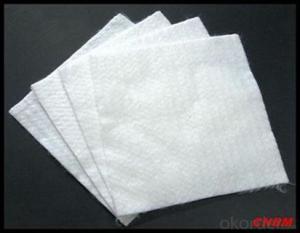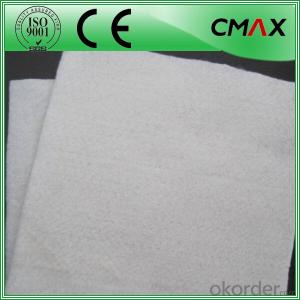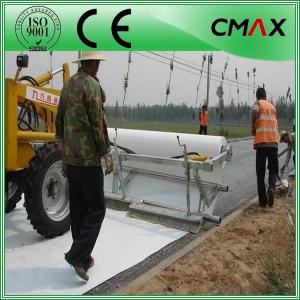Geotextile Landi White Polypropylene Nonwoven Geotextile Used in Construction
- Loading Port:
- China main port
- Payment Terms:
- TT OR LC
- Min Order Qty:
- 1000 g/m²
- Supply Capability:
- 1000000 g/m²/month
OKorder Service Pledge
OKorder Financial Service
You Might Also Like
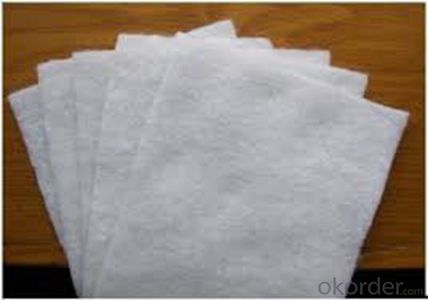
Product
Type:
Geotextiles, Nonwoven Geotextile woven Geotextile
Place of Origin:
Shandong, China (Mainland)
Geotextile uses:
Separate: Geotextile when used as a separation layer prevents two different fill materials such as aggregate and soil from combining. When used correctly the geotextile will increase the life span of the civil project, allowing the two separate layers to perform as designed for longer.
Protection: Geotextile when used as a protection layer acts as a cushioning barrier between the geosynthetic lining system and other layers of the dam or landfill cell. Generally the larger mass rolls of geotextile provide the best cushioning protection. As a protection barrier it helps prevent puncturing and leaks from external forces coming into contact with the liner.
Property:
1.High strength ; low deformation.
2. Durability: steady property, not easy to resolved, airslaked and keep the original property long term.
3. Anti-erosion: anti-acid, anti-alkali, resist insects and mould.
4. Permeability: the woven geotextile can control the sieve size to retain permeability.
Our Service
1.On a regular basis or as per your request,we entrust national testing agencies to conduct quality inspections
2. Strictly in accordance with the ISO9001-2008 international quality system standard,we monitor and manage the whole process throughout production,quality testing,and measurement to ensure product quality
3. For quality-related construction delay or substandard construction(except for damage or losses due to customer’s responsibility or irresistible natural disasters),we have refunding,replacement,and repair services.We will respond to customers’ feedbacks on quality issues within 24 hours.
FAQ:
Q: What kind of payments does jenor support?
A: T/T, L/C, Cash are accepted.
Q: Do you charge for the samples?
A: Accordeing to our company policy, the samples are free, we only charge the freight fee. And we will return the freight fee during the next order.
Q: Can you produce according to customers' design?
A: Sure, we are professional manufacturer, OEM and ODM are both welcome.
Q: Do you have other products?
A: Yes, please check the pictures:
- Q: What are the advantages of using geotextiles in storm surge protection systems?
- Geotextiles offer several advantages in storm surge protection systems. Firstly, they provide a strong barrier against erosive forces, effectively preventing soil erosion and maintaining the stability of the protection system. Secondly, geotextiles are permeable, allowing water to pass through while trapping sediment, thus reducing the risk of clogging and maintaining the functionality of the system. Additionally, geotextiles are lightweight and easy to install, making them a cost-effective and efficient solution for storm surge protection. Lastly, these materials are durable and resistant to degradation from UV rays and chemicals, ensuring a long lifespan and reliable performance in harsh environmental conditions.
- Q: Do you need to suture the lower geotextile of composite geomembrane?
- Look at construction requirements
- Q: What glue glue is used at the seams of the impervious geotextile
- What glue glue is used at the seams of the impervious geotextile
- Q: What are the different geotextile reinforcement techniques?
- Some of the different geotextile reinforcement techniques include geotextile fabrics, geogrids, geocells, and geocomposites. Geotextile fabrics are permeable fabrics made from synthetic materials and are used to stabilize soil and prevent erosion. Geogrids are high-strength materials that are used to enhance the stability of soil by providing tensile reinforcement. Geocells are three-dimensional honeycomb-like structures made from geotextile materials and are used for soil stabilization and erosion control. Geocomposites are combination products that consist of different geotextile materials and are used for various reinforcement applications, such as drainage, filtration, and separation.
- Q: Geotextile 150 * 0.5 * 150 on behalf of what
- This is the composite geomembrane specifications are two cloth a film, 150 grams of geotextile is 0.5MM in the middle of the film, the following is 150 grams of geotextile, compound into
- Q: Are geotextiles resistant to chemicals?
- Yes, geotextiles are generally resistant to chemicals. They are designed to withstand exposure to various chemicals including acids, alkalis, and hydrocarbons without significant degradation. However, the specific chemical resistance of a geotextile can vary depending on its material composition and manufacturing process.
- Q: Geotextile (two cloth a film) to detect the frequency requirements? On behalf of the number?
- Geotextile and geomembrane detection frequency is 100 volumes detection time.
- Q: Where to sell black geotextile prices
- I have 6 meters per square meter to 1 block
- Q: What are the factors to consider when designing geotextile-reinforced slopes?
- When designing geotextile-reinforced slopes, several factors need to be considered. These include the type and strength of geotextile to be used, the slope angle and height, soil properties, expected loads and stresses, water drainage and erosion control measures, construction methods, and long-term performance requirements. Additionally, site-specific conditions such as climate, vegetation, and nearby structures should also be taken into account. Proper consideration of these factors ensures a safe and stable design that effectively mitigates slope failures and erosion.
- Q: Can geotextiles be used in the construction of artificial islands?
- Yes, geotextiles can be used in the construction of artificial islands. Geotextiles are permeable fabrics that can provide effective soil stabilization, erosion control, and filtration. They can be used as a protective layer between the island's foundation and the surrounding water, preventing erosion and promoting stability. Additionally, geotextiles can assist in the drainage system of the island, allowing excess water to flow through while retaining the soil. Thus, geotextiles are a valuable tool in the construction and maintenance of artificial islands.
Send your message to us
Geotextile Landi White Polypropylene Nonwoven Geotextile Used in Construction
- Loading Port:
- China main port
- Payment Terms:
- TT OR LC
- Min Order Qty:
- 1000 g/m²
- Supply Capability:
- 1000000 g/m²/month
OKorder Service Pledge
OKorder Financial Service
Similar products
Hot products
Hot Searches
Related keywords

